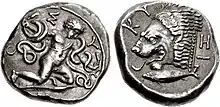Idyll XXIV
Idyll XXIV, also called Ἡρακλίσκος (Heracliscus; 'The Little Heracles'), is a poem by the 3rd-century BC Greek poet Theocritus.[1][2] This poem describes the earliest feat of Heracles, the slaying of the snakes sent against him by Hera, and gives an account of the hero's training.[3]
Summary
The poem tells first how the infant Heracles killed the two snakes sent by the outraged Hera to devour him, and next of the rites which the seer Teiresias advised his mother Alcmena to perform in order to avert her wrath.[2] We are then told of the education of Heracles, and the poem breaks off abruptly in the manuscripts.[2] After there is an account of his diet and clothing.[2]
Analysis

According to Andrew Lang, the "vivacity and tenderness of the pictures of domestic life, and the minute knowledge of expiatory ceremonies" seem to mark this idyll as the work of Theocritus.[3] The following poem, Idyll XXV, also deals with an adventure of Heracles, and Lang thinks it not impossible that Theocritus wrote, or contemplated writing, a Heraclean epic, in a series of idylls.[3]
According to J. M. Edmonds, "This epic poem, unlike the Hylas, is not an artistic whole."[2] Of the historical context, he writes, "Such a poem would doubtless be acceptable at the Alexandrian court in the early years of the child who was afterwards Ptolemy III. For the Ptolemies claimed descent from Heracles."[2]
See also
References
- Acosta-Hughes 2012, p. 249.
- Edmonds, ed. 1919, p. 289.
- Lang, ed. 1880, p. 117.
Sources
- Acosta-Hughes, Benjamin (2012). "Miniaturizing the Huge: Hercules on a Small Scale (Theocritus Idylls 13 and 24)". In Baumbach, Manuel; Bär, Silvio (eds.). Brill’s Companion to Greek and Latin Epyllion and Its Reception. Leiden, The Netherlands: Brill. pp. 245–57. doi:10.1163/9789004233058_012. ISBN 9789004233058.
Attribution: ![]() This article incorporates text from this source, which is in the public domain.
This article incorporates text from this source, which is in the public domain.
- Edmonds, J. M., ed. (1919). The Greek Bucolic Poets (3rd ed.). William Heinemann. pp. 289–99.
- Lang, Andrew, ed. (1880). Theocritus, Bion, and Moschus. London: Macmillan and Co. pp. 117–23.
Further reading
- Cholmeley, R. J., ed. (1919). The Idylls of Theocritus (2nd ed.). London: G. Bell & Sons, Ltd. pp. 354–62.
- Fawkes, Francis (1767). The Idylliums of Theocritus. London: Dryden Leach. pp. 224–35.
- Gow, A. S. F. (1942). "Theocritus, Idyll XXIV—Stars and Doors". The Classical Quarterly. 36 (3/4): 104–10. JSTOR 636619.
- Trevelyan, R. C. (1947). A Translation of the Idylls of Theocritus. Cambridge: Cambridge University Press. pp. 75–8.
- Stern, Jacob (1974). "Theocritus' Idyll 24". The American Journal of Philology. 95 (4): 348–61. doi:10.2307/294015. JSTOR 294015.
- White, Heather (1977). "Doors and Stars in Theocritus, Idyll XXIV". Mnemosyne. 30 (2): 135–40. JSTOR 4430684.
External links
 Greek Wikisource has original text related to this article: Ηρακλίσκος
Greek Wikisource has original text related to this article: Ηρακλίσκος- "Theocritus, Idylls, Ἡρακλίσκος". Perseus Digital Library.
